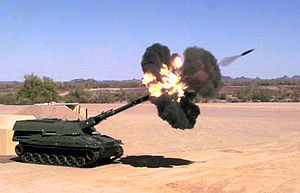XM2001 Crusader: Difference between revisions
No edit summary |
|||
| Line 97: | Line 97: | ||
==External links== |
==External links== |
||
*{{ru icon}} [http://www.dogswar.ru/oryjeinaia-ekzotika/bronetehnika/2042-samohodnaia-gaybica-.html XM2001 Crusader from DogsWar.ru] |
|||
*[http://www.npr.org/dmg/dmg.php?prgCode=ATC&showDate=08-May-2002&segNum=3&mediaPref=RM NPR: Crusader Artillery System] - [[All Things Considered]], May 8, 2002 - Although the [[The Pentagon|Pentagon]] has finally announced the death of the Crusader artillery system, [[National Public Radio|NPR]] Senior News Analyst [[Daniel Schorr]] says that the underlying controversy points to a serious failing in the ideal of "unified" civilian control of the military. ([[RealAudio]]) |
*[http://www.npr.org/dmg/dmg.php?prgCode=ATC&showDate=08-May-2002&segNum=3&mediaPref=RM NPR: Crusader Artillery System] - [[All Things Considered]], May 8, 2002 - Although the [[The Pentagon|Pentagon]] has finally announced the death of the Crusader artillery system, [[National Public Radio|NPR]] Senior News Analyst [[Daniel Schorr]] says that the underlying controversy points to a serious failing in the ideal of "unified" civilian control of the military. ([[RealAudio]]) |
||
Revision as of 21:02, 26 February 2011
The XM2001 Crusader was to be the United States Army's next-generation self-propelled howitzer (SPH), designed to improve survivability, lethality, mobility, and effectiveness and planned to be introduced by 2008. United Defense was the prime contractor; General Dynamics the major subcontractor. In early May 2002, Secretary of Defense Donald Rumsfeld cancelled the $11 billion USD program because he considered it neither mobile nor precise enough.[1] The prototype was on display at the cannon park at Fort Sill, Oklahoma but was recently moved inside the Department of Logistics motorpool.
Background
The Crusader was intended to replace the M109A6 Paladin Self-Propelled Howitzer and the M992 Field Artillery Ammunition Support Vehicle (FAASV). It was intended to be an automated gun (as opposed to missile) artillery system to support the Interim Brigade Combat Teams (IBCT) Counterattack Corps and a basis for other vehicle developments.
Key features of the Crusader design included:
- Two Crusaders would fit in a C-17 Globemaster.
- A cooled XM297E2 howitzer for sustained high rates of fire
- Automated ammunition handling and loading
- State-of-the-art cockpit with embedded command and control
- Composite armor
- Survivability features to protect the vehicle and crew
- LV100-5 gas turbine engine (common with the Abrams tank) to keep up with other fighting vehicles
Using the same chassis, the resupply vehicles (RSVs) would deliver automatic, reciprocal transfer of ammunition, data and fuel to the SPH or another RSV.
Program Timeline
- 1QFY95 Approved to commence program definition and risk reduction (PDRR) phase.
- 2QFY98 In-process review completed and manufacture of the PDRR prototype systems begun.
- 3QFY99 Delivery of first RSV prototype.
- 2QFY00 Delivery of first prototype howitzer SPH 1.
- 1QFY02 Successful preliminary design review.
- 1QFY02 More than 4000 rounds fired from SPH 1.
- 2QFY02 Program discontinued.
General Characteristics
| SPH | RSV-T | RSV-W | |
| Curb Weight | 40 tons | 36 tons | 33.3 tons |
| Length | 7.53 m | 7.53 m | 11.03 m |
| Width | 3.31 m | 3.31 m | 2.44 m |
| Height | 3.00 m | 3.00 m | 3.59 m |
| Cross-Country Mobility | 39–48 km/h | 39–48 km/h | 64 km/h |
| Armament | Cooled 155 mm | none | none |
| Max Range | 40–50 km (assisted) | ||
| Rate of Fire/Resupply | 10-12 rounds/min | 48 rounds in 10 min | 48 rounds in 10 min |
| Crew | 3 | 3 | 3 |
- Prime Contractors: United Defense, L.P. (Minneapolis, Minnesota)
- Foreign Counterpart: PzH 2000, K9, AS90
- Foreign Military Sales: None planned
Eventual Fate
The Crusader program was cancelled, partly due to the $25 million per vehicle cost (compared to the German PzH 2000 cost of $4.5 million). The Pentagon preferred the Crusader design, largely due to its lighter weight. It also had a speed of around 40 mph (64 km/h) compared to the PzH 2000 speed of around 37 mph (60 km/h). However, the Pentagon refused German suggestions of producing a PzH that would have detachable armor, which could be shipped separately, or substituting titanium for steel in many parts. The PzH 2000 also required a crew of two more men, considered a disadvantage, but which could also be an advantage. That is, if the crew is cross-trained, and a driver is killed, he could be substituted by another crewman, and vice versa.
Another consideration was that the existing Paladin already had advanced characteristics, making it still a very effective weapon.
Much of the technologies developed by the program have been incorporated into the now cancelled XM1203 Non-Line-of-Sight Cannon
References
External links
- Template:Ru icon XM2001 Crusader from DogsWar.ru
- NPR: Crusader Artillery System - All Things Considered, May 8, 2002 - Although the Pentagon has finally announced the death of the Crusader artillery system, NPR Senior News Analyst Daniel Schorr says that the underlying controversy points to a serious failing in the ideal of "unified" civilian control of the military. (RealAudio)

